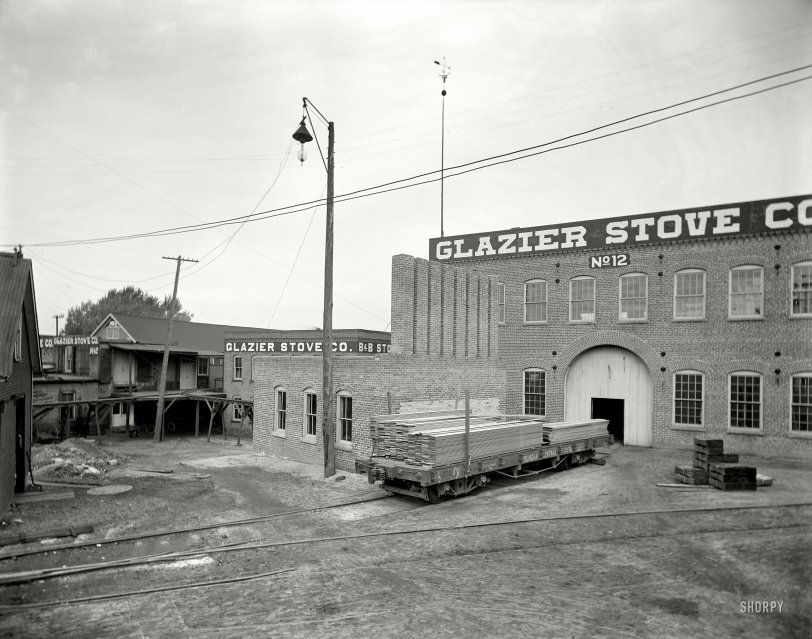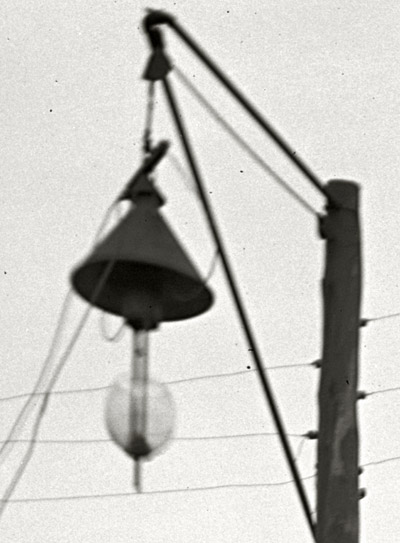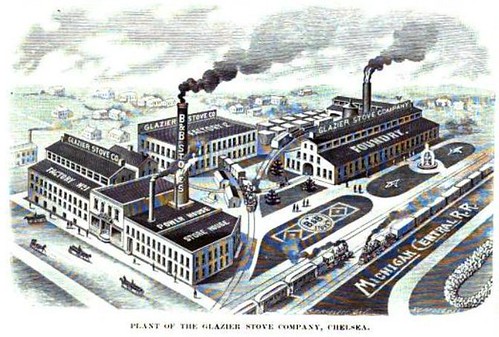


Framed or unframed, desk size to sofa size, printed by us in Arizona and Alabama since 2007. Explore now.
Shorpy is funded by you. Patreon contributors get an ad-free experience.
Learn more.

- Freeze Frame
- Texas Flyer wanted
- Just a Year Too Soon
- WWII -- Replacing men with women at the railroad crossing.
- Yes, Icing
- You kids drive me nuts!
- NOT An Easy Job
- I wonder
- Just add window boxes
- Icing Platform?
- Indiana Harbor Belt abides
- Freezing haze
- Corrections (for those who care)
- C&NW at Nelson
- Fallen Flags
- A dangerous job made worse
- Water Stop
- Passenger trains have right of way over freights?
- Coal
- Never ceases to amaze me.
- Still chuggin' (in model form)
- Great shot
- Westerly Breeze
- For the men, a trapeze
- Tickled
- Sense of loneliness ...
- 2 cents
- Charm City
- What an Outrage
- Brighton Park
Print Emporium
Glazier Stove Works: 1901

Chelsea, Michigan, circa 1901. "Brass foundry, Glazier Stove Co." Shorpy makes an exciting visit to the stove factory. Detroit Publishing Co. View full size.
Glazier Stove 2003
Here is a photo of an Amtrak train passing the Glazier Stove Company in 2003. Photo by Robert Teed.

A different trade
How much more appropriate if Mr. Glazier had taken up a different line of work. Say, in the manufacture of windowpanes.
Carbon Arc Lamps
I have read about these in my 1917 Hawkins Electrical manuals. They usually operated at 50 volts with a draw of 15 amperes or so. A real heat producer! The carbons had to be changed regularly, that is why there is such a long drop wire going to the lamp. You can also see the pullies and cord used to lower the fixture, so that it can be lowered for servicing.
Plant Expansion
Building 12 looks brand-new, possibly still under construction. Doesn't look like there's any stove work going on inside.
Tramway
Great picture. There's an elevated tramway at left, and it looks like it has wooden rails.
Detroit, Stove City!
In 1880, Detroit was the recognized center of the stove-making industry. But by 1902 the growth of other industries had relegated stove-making to sixth place in Detroit. An industry boom pushed stove-making back into second place by 1922.
In 1860, Jeremiah Dwyer and his brother James started the city's first stove factory at the foot of Mt. Elliott on the near east side, where they prospered and expanded. The stoves could burn wood, coal or coke. Their success attracted others to the area. Gas ranges also became more popular and later replaced the old style stoves. By 1922 Detroit makers built 400,000 stoves worth $10 million in one year.
The industry was dominated in the city by five major firms: The Michigan Stove Company, The Detroit Stove Works, The Penninsular Stove Company, the Art Stove Company, and the Detroit Vapor Stove Company. In later years the Welbilt Company emerged as the last surviving stove company and inherited the giant stove.
From The Detroit News: http://apps.detnews.com/apps/history/index.php?id=198#ixzz0uMQIVV8C
Two years later
Frank Glazier began a downward spiral. Sad ending for a man who did a lot of good.
Brightest & Best
Sights and Scenes Along the Michigan Central Line
Chicago Photo-Engraving Company, 1895The Glazier Stove Company
Manufacturers of the "Brightest and Best" oil and gas stoves, dealers in coal, lumber and builders' supplies. This concern is the largest manufacturing establishment in this vicinity, and one of the largest in State, The business was commenced in a small way by the present proprietor, Mr. Frank P. Glazier, in 1890, and has gradually grown, through careful management, energy and progressive ability until it has assumed its present large proportions, ranking with some of the best manufacturing enterprises of the country. The growth has not been uninterrupted, however, neither has there been any lack of competition to retard its development, but by close attention to business, producing high grade goods and keeping their product and its merits constantly before the public, they have succeeded in not only building up a large trade, but through their own success have contributed to the material welfare of Chelsea. In March, 1895, the entire plant, with the exception of the offices. storage building, and power house, was destroyed by fire. Not disheartened, however, they immediately set to planning for a more extensive and better equipped plant, with its capacity largely increased by modern machinery of the finest quality, and every labor-saving device imaginable for producing better work and more of it than ever attempted before, They employ 120 men nine months in the year, and have facilities for the manufacturing of 300 oil and gas stoves a day.
Their B. & B. trade mark brand, which stands for"Brightest and Best," is considered by the trade to be better in style, quality. finish and durability than any other stoves in the market. Right at this point, we desire to give special recognition to Mr. Glazier. He is a born business man, and is possessed of more than ordinary executive ability, thoroughly reliable in all respects, prompt and honorable in his relations with mankind, affable, enterprising and liberal, and his present prosperous business is a fitting monument to his industry, honesty and integrity. He is prominent in every movement conducive to the welfare and prosperity.
Some Streetlight
Wow: what an unusual bulb in the street light.
[The "bulb" is the globe of a carbon arc lamp. - Dave]

Brick by Brick.
The brickwork in the arch around the large door is amazing! also are the eight brick 'chimneys' on the structure to the left of the flat car.
Bricks built the modern world in the Victorian Era.
Note the narrow-gauge plant railway on the trestle work.
The Steam Railway flat car from the Michigan Central is of an older pattern, not having air brakes, and is constructed almost all of wood.
The truss rods beneath the car can be tightened with the eye shown to keep the car deck level and straight.
Altho' a poor place to ride on a freight car, this is where a hobo might ride when 'riding the rods', adding scrap lumber to make a platform of sorts.
Vertical 'stake pockets' are mounted along the side of the car to take wooden stakes shimmed in with wedges to hold the load on the car.
Often the tops of the stakes would be tied together across the load with wire for extra strength.
The shaft of the hand brake wheel is bent.
On later flat cars the wheel could be lowered into a round recessed into the timbers in the car deck by moving a U-shaped swivel at the bottom of the shaft.
A Trainman was wise to stand back from the end of a car when being pushed by a locomotive, as a sudden jolt from slack in the car couplings could knock him off balance and down between the rails in front of the car to then get run over.
The temptation to stand on the very front and 'show off' is very great, especially when passing a station with patrons out front.
On this car the brake beams and their shoes are outside the trucks, the coupler knuckle has a slot in it to accommodate an adapter link which would allow the car to be coupled to older cars still using link and pin couplings.
The knuckle has a vertical hole thru it for a pin, and the hole is still found on modern cars 100 years later, but, the slot is not.
A red flag on a round wooden staff would be inserted into this hole to signify the car was the end of a train where corner brackets for coal oil marker lamps were not applied.
Don't overlook the weathervane.
Thank You.
Look, Ma -- no air!
That Michigan Central Railroad flatcar is not equipped with automatic air brakes as per the 1893 railroad safety appliance act. It may be restricted to service only within Michigan or could have become a car owned by the Glazier Stove and just used on their private sidings. From the looks of how the load is secured on the deck-I'd say the car is restricted to intra factory use.
Citizen Frank
Frank Glazier was an old-school entrepreneur who combined philanthropy with self-interest, and much of the Chelsea, Michigan he built survives. He got 5 to 10 in Jackson Prison when a 1908 bankruptcy hearing found that his wife had destroyed all his financial records "because they upset" her husband.
He was pardoned in 1912 and died in 1922.
Elevated tracks
I can picture some type of push car like railroad workers used running back and forth between the buildings hauling heavy iron parts. On the weekends could see Mr. Glazier's children and grandchildren playing or begging to ride on those cars. Wonder if it ever happened.

























On Shorpy:
Today’s Top 5